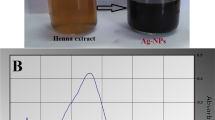Abstract
In this study the effect of oil droplet size on antimicrobial activity was investigated. Oil-in-water emulsions were made from oil possessing antimicrobial properties (lemon myrtle oil, LMO), and oil which has no antimicrobial properties (soybean oil). The antimicrobial properties were investigated against 5 bacteria. The emulsions containing millimetre size and micron-size droplets were produced by hand-shaking and blending using a high speed blender and nanoemulsions were produced using a microfluidizer at 60 MPa. It was found that all emulsions made from LMO had the same level of antimicrobial effects against the 5 bacteria whereas all soybean oil emulsions had no antimicrobial effect. From these results, it could be concluded that the antimicrobial property of nanoemulsions result from the active ingredients in the emulsions and not from high surface tensions and cell wall diffusion activity of nano-sized droplets.
Similar content being viewed by others
References
Yaghmur A, De Campo L, Sagalowicz L, Leser M, Glatter O, Michel M, Watzke H, Watzke HJ. Oil-in-water emulsion for delivery of active compounds, e.g., flavor and vitamins, comprises oil droplets exhibiting nano-sized structure containing hydrophilic domains and formed by lipophilic additive. Patent No. EP1598060-A1 (2005)
Choi AJ, Kim CJ, Cho YJ, Hwang JK, Kim CT. Effects of surfactants on the formation and stability of capsaicin-loaded nanoemulsions. Food Sci. Biotechnol. 18: 1161–1172 (2009)
Bhavsar MD, Tiwari SB, Amiji MM. Formulation optimization for the nanoparticles-in-microspere hybrid oral delivery system using factorial design. J. Control. Release 110: 422–430 (2007)
Magdassi S, Dayan B, Levi-ruso G. Pesticide nanoparticles Obtained from microemulsions and nanoemulsions. Patent No. WO/ 2008/032328 (2008)
Hamouda T, Hayes MM, Cao ZY, Tonda R, Johnson K, Wright DC, Brisker J, Baker JR. A novel surfactant nanoemulsion with broadspectrum sporicidal activity against Bacillus species. J. Infect. Dis. 180: 1939–1949 (1999)
Hamouda T, Myc A, Donovan B, Shih AY, Reuter JD, Baker JR. A novel surfactant nanoemulsion with a unique non-irritant topical antimicrobial activity against bacteria, enveloped viruses, and fungi. Microbiol. Res. 156: 1–7 (2001)
Myc A, Vanhecke T, Landers JJ, Hamouda T, Baker JR. The fungicidal activity of novel nanoemulsion (X8W60PC) against clinically important yeast and filamentous fungi. Mycopathologia 155: 195–201 (2002)
Baker JR, Shih A, Myc A, Hamouda T. Composition for anti-fungal treatment comprises an antimicrobial oil-in-water nanoemulsion containing a solvent and a surfactant. Patent No. WO2003000243-A, WO2003000243-A1 (2003)
Chepurnov AA, Bakulina LF, Dadaeva AA, Ustinova EN, Chepurnova TS, Baker JR. Inactivation of ebola virus with a surfactant nanoemulsion. Acta Trop. 87: 315–320 (2003)
Teixeira PC, Leite GM, Domingues RJ, Silva J, Gibbs PA, Ferreira JP. Antimicrobial effects of a microemulsion and a nanoemulsion on enteric and other pathogens and biofilms. Int. J. Food Microbiol. 118: 15–19 (2007)
Hamouda T, Baker JR. Antimicrobial mechanism of action of surfactant lipid preparations in enteric Gram-negative bacilli. J. Appl. Microbiol. 89: 397–403 (2000)
Hammer KA, Carson CF, Riley TV. Antimicrobial activity of essential oils and other plant extracts. J. Appl. Microbiol. 86: 985–990 (1999)
Burt SA, Reinders RD. Antibacterial activity of selected plant essential oils against Escherichia coli O157: H7. Lett. Appl. Microbiol. 36: 162–167 (2003)
Choi SI, Chang KM, Lee YS, Kim GH. Antibacterial activity of essential oils from Zanthoxylum piperitum A.P. DC. And Zanthoxylum schinifolium. Food Sci. Biotechnol. 17: 195–198 (2008)
Hayes AJ, Markovic B. Toxicity of Australian essential oil Backhousia citriodora (lemon myrtle). Part 1. Antimicrobial activity and in vitro cytotoxicity. Food Chem. Toxicol. 40: 535–543 (2002)
Jafari SM, He YH, Bhandari B. Nano-emulsion production by sonication and microfluidization — A comparison. Int. J. Food Prop. 9: 475–485 (2006)
Huynh VT. Encapsulation of lemon myrtle oil and its biological functionalities. MPhil Thesis, The University of Queensland, Brisbane, Australia (2007)
Wilkinson JM, Hipwell M, Ryan T, Cavanagh HMA. Bioactivity of Backhousia citriodora: Antibacterial and antifungal activity. J. Agr. Food Chem. 51: 76–81 (2003)
Author information
Authors and Affiliations
Corresponding author
Rights and permissions
About this article
Cite this article
Buranasuksombat, U., Kwon, Y.J., Turner, M. et al. Influence of emulsion droplet size on antimicrobial properties. Food Sci Biotechnol 20, 793–800 (2011). https://doi.org/10.1007/s10068-011-0110-x
Received:
Revised:
Accepted:
Published:
Issue Date:
DOI: https://doi.org/10.1007/s10068-011-0110-x




